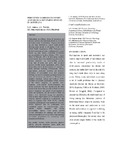Please use this identifier to cite or link to this item:
http://hdl.handle.net/10311/692| Title: | Perceived barriers to sport and recreation participation in Botswana |
| Authors: | Amusa, L.O. Toriola, A.L. Onyewadume, I.U. Dhaliwal, H.S. |
| Keywords: | Barriers Health problems Physical activity Physical recreation Sport Sport and recreation services Target groups |
| Issue Date: | 2008 |
| Publisher: | AFAHPER-SD. http://ajol.info/index.php/ajpherd/index |
| Citation: | Amusa, L.O. et al (2008) Perceived barriers to sport and recreation participation in Botswana, African Journal for Physical, Health Education, Recreation and Dance (AJPHERD), Vol. 14, No. 2, pp. 115-129 |
| Abstract: | Participation in different forms of recreation and physical activities has beneficial effects on the health and health status of individuals. Physical inactivity has also been identified as a major health problem affecting many people in all regions of the world (World Health Organisation, 2002). Participation in physical recreation activities is influenced by several factors, e.g. time, interest, availability of facilities and accessibility to facilities (Scholtz, 1995; Sayed, Meyer & Monyeki, 2004). In developing countries several factors have been identified as precursors of physical inactivity, e.g. overcrowding, poverty, crime, lack of parks, and sports and recreation facilities (World Health Organisation, 2002). These factors often lead to the development of a number of health problems including hypokinetism, obesity, hypertension, premature mortality and increased prevalence of concomitant social and economic problems. In order to determine perceived barriers to sport and recreation participation in Botswana the modified Crawford, Jackson and Godbey’s (1991) constraint assessment questionnaire which focused on five barrier categories, i.e. aptitude, socio- economic, socio-cultural, facility-awareness and facility constraint, was used. Specifically, the study examined the factors that preclude or limit Botswana people’s frequency and quality of participation in sports and recreation, and the extent to which the barriers were distributed among the population. From an initial target sample of 2195 residents in six randomly selected communities in Botswana, data based on responses from 1664 (75.8%) correctly completed questionnaires were statistically analysed. Results indicated that the participants were constrained mainly by socio-economic, socio- cultural, facility awareness and facility inaccessibility barriers. These results provide relevant information for planning and delivering sport and recreation services as well as implementing intervention programmes for community health promotion in Botswana. |
| URI: | http://hdl.handle.net/10311/692 |
| ISSN: | 1117-4315 |
| Appears in Collections: | Research articles (Dept of Physical Education) |
Files in This Item:
| File | Description | Size | Format | |
|---|---|---|---|---|
| Omyewadume_AJPHERD_2008.pdf | 813.82 kB | Adobe PDF |  View/Open |
Items in DSpace are protected by copyright, with all rights reserved, unless otherwise indicated.
